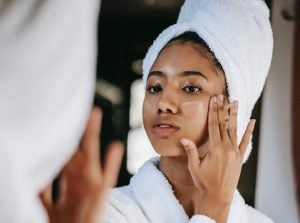
Environmental racism exists in our beauty products and must be addressed
Jennifer Ortega, Research Analyst, Environmental Health
Environmental racism is everywhere. At the neighborhood level, communities of color often experience worse air quality, fewer green spaces, or face more extreme temperatures. At the household level, families of color and low-income families experience a higher risk of lead in their drinking water and higher utility debt and energy insecurity. Inequities are even manifested in the items we use every day, with personal care products marketed to women of color often containing more toxic ingredients than those marketed to white women.
These toxic exposures are not driven by individual choices, but rather by where one lives, where one works, and by cultural beauty standards and norms. A new personal care product story map (also available in Spanish) consolidates federal labor and census data, as well as information from public health studies to show how the intersection of different factors manifests in racial disparities in the exposure to toxic ingredients in personal care products. The map is part of an interactive web series, led by Tamarra James-Todd, Ph.D., and her team at Harvard T.H. Chan School of Public Health.
Neighborhoods with more toxic hair products ─ The availability of safer products can vary depending on where one lives.
Dr. James-Todd’s team evaluated the safety of hair products available in seven Boston neighborhoods using product scores from the Environmental Working Group’s Skin Deep database. In the Roxbury neighborhood, 50% more of the hair products sold were classified as high-hazard compared to those sold in Beacon Hill, a few miles north. In the Roxbury neighborhood, 51% of residents are Black and 34% of residents live in poverty. In the Beacon Hill neighborhood, 2% of residents are Black and 8% of residents live in poverty.
Access plays a critical role in toxic chemical exposure disparities. The information from the story map highlights the need for safer personal care products to be available in all retail stores everywhere. These safer products must also be affordable.
Stark inequities for certain workers ─ Where one works can impact exposures to certain toxic chemicals.
Nail salon workers have higher urinary concentrations of certain toxic chemicals compared to the general population, according to the story map. Products used in nail salons contain many hazardous ingredients, including dibutyl phthalate, formaldehyde and toluene, among others. These chemicals can cause irritation in the eyes and skin and can lead to more serious effects like reproductive harm or cancer. Although people of Asian descent make up less than 10% of the U.S. workforce, they comprise 76% of all nail salon workers. Moreover, 81% of nail salon workers are women and 58% are of reproductive age (i.e. 25-44 years old) and at a potentially higher risk of suffering health effects from toxic chemical exposures.
Nail salon workers are often especially vulnerable to toxic chemical exposures because of how frequently they use nail products. The story map highlights the need for safer work environments and the need for safer ingredients used by these professionals.
Toxic disparities must be eliminated
It’s clear there is an urgent need for clean beauty justice ─ affordable, safer personal care products for people of color. The provisions of the Federal Food, Drug, and Cosmetic Act dealing with cosmetics have not been substantially updated since 1938. Since then, a countless number of cosmetic and personal care product ingredients have been introduced in the market without the requirement of a review or approval by the Food and Drug Administration (FDA).
Scientific resources such as the story map show how the production and marketing of more toxic personal care products to women of color is a form of environmental racism. Congress, FDA and product manufacturers all need to increase their efforts to make safer products available, accessible and affordable for everyone. Only when all these actors take appropriate steps can we achieve clean beauty justice.
In the meantime, the dissemination of public health research that illuminates the extent of clean beauty injustice, its root causes and the associated adverse health effects is vitally important. Tools like the story map that walk audiences through the data help inform everyone about these toxic inequities in an accessible way.
Visit the new environmental racism story map, and take their survey (Spanish version) to share your own insights about how the map is helping to build awareness about this issue.












